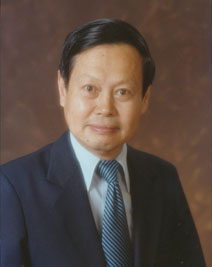| Chen Ning Yang  Born: 1-Oct-1922 [1] Born: 1-Oct-1922 [1]
Birthplace: Hofei, Anwhei, China
Gender: Male
Race or Ethnicity: Asian
Sexual orientation: Straight
Occupation: Physicist Nationality: United States
Executive summary: Particle physicist Chen Ning Yang is a Nobel Prize winning Chinese American physicist and mathematician. His contributions are wide ranging and impressive (he has published over 200 papers) but he is best known for the Yang-Mills theory, the Yang-Baxter equation, and his work with T.D. Lee on parity nonconservation in weak interactions -- for which they shared the 1957 Nobel Prize in physics.
Yang developed an early interest in mathematics and physics, especially group theory, through materials and discussions provided by his mathematician father K. C. Yang. After receiving his master degree level training in China, Yang traveled to the U.S. hoping to study with Enrico Fermi, following him ultimately to the University of Chicago in 1946. But Fermi, ensconced at the Argonne National Laboratory (which did not allow foreign nationals), redirected him to study under Edward Teller and S. K. Allison on the Cockcroft-Walton accelerator. Although Yang successfully received his Ph.D., he found experimental work frustrating and opted to do his postdoctoral work at the Institute for Advanced Study in Princeton under renowned theoretician Robert Oppenheimer.
Aside from a year at the National Laboratory in Brookhaven (home of the Cosmotron) from 1953-54, Yang essentially spent the next seventeen years at Princeton. When Oppenheimer retired (in 1965) he asked Yang to succeed him as Director of the Institute but Yang refused saying, "I shall not enjoy the life of a Director." Ultimately Yang was lured to the State University of New York at Stony Brook in 1966 to fill the dual roles of Einstein Professor and Director of the newly created Institute for Theoretical Physics (a much smaller and more manageable institute). He would later be credited with transforming the "fledgling institution into a great university" (J. S. Toll, former SUNY President).
Eventually Yang's emerging ability to create hubs of scientific learning would extend to his efforts to bridge relations between the U.S. and mainland China. After working hard to help establish Sino-American diplomatic relations (1979), he founded the CEEC fellowship at Stony Brook (1981), inviting visiting scholars from Chinese universities and research institutions to participate at the Institute. In 1983 he established the foundation for the Center for Advanced Research at Zhongshan University and became its Chairman. In 1986 he organized a theoretical physics division at the Nankai Institute of Mathematics.
But it is for his scientific contributions that Yang will principally be remembered. His Yang-Mills theory is considered an epoch-making contribution, laying the foundation, and supplying the fundamental principles and equations, for the whole of particle physics. His work with Lee on parity nonconservation in weak interactions solved a problem in particle physics that had baffled his peers, meanwhile influencing the development of theories on symmetry in physics. His Yang-Baxter equation has proven to be a fundamental mathematical structure whose relevance has been found in such areas of math and physics as one-dimensional quantum mechanics problems, two-dimensional classical statistical mechanical problems, conformal field theory, knot and braid theory, operator theory, Hopf algebra, quantum group theory, and the topology of three-dimensional manifolds.
In addition to the Nobel Prize, Yang has received numerous awards and distinctions including the Albert Einstein Commemorative Award (1957), the Rumford Prize (1980), and the U.S. National Medal of Science (1986).
[1] Most official documents bear the erroneous birth date of 22 September 1922. Father: Ke Chuan Yang
Mother: Meng Hwa Loh Yang
Wife: Chih Li Tu (m. 1950, d. 2003)
Son: Franklin (b. 1951)
Son: Gilbert (b. 1958)
Daughter: Eulee (b. 1961)
High School: Kun Hua Middle School, Kunming, China (1938)
University: Southwest Associated University, China (1942)
University: Tsing Hua University, China (1944)
University: PhD Physics, University of Chicago (1948)
Professor: Stony Brook University (1965-99)
Nobel Prize for Physics 1957 (shared)
Rumford Prize 1980
National Medal of Science 1986
Albert Einstein Medal 1995
American Physical Society Fellow
Institute for Advanced Study 1949-65
Pontifical Academy of Sciences
Official Website:
http://insti.physics.sunysb.edu/~yang/
Author of books:
Elementary particles; a short history of some discoveries in atomic physics (1961)
Selected Papers 1945-1980 With Commentary (1983)
Braid Group, Knot Theory and Statistical Mechanics II (Advanced Series in Mathematical Physics, Vol 17) (1994)
Requires Flash 7+ and Javascript.
Do you know something we don't?
Submit a correction or make a comment about this profile
Copyright ©2019 Soylent Communications
|